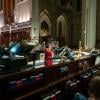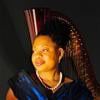
San Francisco’s Grace Cathedral seems like an unlikely setting for Mardi Gras revelry and all of the celebration’s sensual history. But the towering sacred space on Nob Hill is hosting its annual “Carnivale” fundraising gala on Feb. 13, and that’sright in line with the institution’s mission statement: “reimagining church with courage, joy, and wonder.”
“It used to be a supper dance that we would have at the Fairmont hotel,” said the Very Rev. Malcolm Clemens Young in a recent phone interview. The cathedral’s ninth dean, he’s served since 2015. “It was controversial moving into here for lots of different reasons — women in these sometimes revealing ball gowns and men dressed to the nines, having bars in different places in the cathedral.
“Then there are even just the practical parts. We have limestone floors, so they absorb things like red wine when we spill things on them. And it’s very hard to clean,” Young continued. “But it’s a great party. I think this is the 14th one we’ve had.”

While the gala itself includes cocktails, dinner, and an auction, “The Late Night Revelry” after-party includes music by DJ, vocalist, and multi-instrumentalist Chris Clouse and jazz harpist and composer Destiny Muhammad. With more cocktails, a photo booth, and a later starting time, the after-party appeals to a different part of the gala’s demographic, Young reckons.
“It is definitely a much younger vibe at the after-party,” he observed. “We have something to offer for people who want to be in bed by 10:30 p.m., and we have something for people who want to dance the night away.”
San Francisco and New Orleans are two cultural centers of the U.S., and Grace Cathedral itself provides a connection between them. “The two longest-term deans [at Grace Cathedral], J. Wilmer Gresham and C. Julian Bartlett, both lived in New Orleans,” Young pointed out. “We do have this vision that if you live in San Francisco and want to celebrate Mardi Gras, you fly back to New Orleans. But if you can’t leave town, Grace Cathedral is the place to be.”
Bartlett, in fact, planted the seeds for one of Grace Cathedral’s landmark musical events, the Duke Ellington Orchestra’s Concert of Sacred Music in 1965. (SFJAZZ, which has been co-producing independent concerts at Grace Cathedral since 1986, presented 25th- and 50th-anniversary recreations of that performance in 1990 and 2015.)
“Bartlett was a jazz fan who would go to North Beach and listen to jazz,” said Rebecca Nestle, Grace Cathedral’s director of events and cultural programs. “And he met Duke Ellington at a jazz club and told him, ‘You should come and do something at Grace Cathedral.’
“Then, of course, Vince Guaraldi [jazz pianist and Peanuts composer] did his Mass here as well, also in 1965,” Nestle added. “Those are beautiful pieces, both of them.”
As well as working with outside presenters like SFJAZZ (and, more recently, Noise Pop and the Great American Music Hall), Nestle directs a range of activities and events at the church. “I’m responsible for all of our in-house arts programming,” she explained. “That includes some of Grace Cathedral’s better-known offerings, like its organ recitals and Christmas concerts, as well as its annual artist-in-residence.” (Current artist-in-residence Bobby McFerrin leads his next Circlesongs, “spontaneously composed choral pieces,” on Feb. 11.)

“I’m also responsible for our The Forum conversations series; Grace Light, which is a light installation; and Spacious Grace, which is our mini-art festival where we take the pews out of the center of the cathedral and explore the space in new ways,” Nestle noted. “And I co-produce Sound Baths with my colleague Eva Woo Slavitt, who is the director of marketing. And she does Yoga on the Labyrinth. Those are part of Grace Cathedral’s Mind, Body, and Spirit programming.”
With around 125 events a year, Grace Cathedral receives far more visitors than weekly congregants. “We do occasionally have people come in while we’re doing one of our performance events and ask if Grace Cathedral is still a working church,” Nestle said.
Along with the National Cathedral in Washington, D.C., and the Cathedral of St. John the Divine in Manhattan, Grace Cathedral is one of three Episcopal churches in the U.S. designed in a massive Gothic style. Of the three, Grace Cathedral has the broadest non-parochial offerings and alternately reflects and influences San Francisco’s civil climate.
“An important thing that we want to do is be a house of prayer for all people. So whenever we have the opportunity to work with other faiths, we do,” Nestle said. “We’re always very eager to hear from performing arts groups that want to bring something from the Jewish tradition or the Islamic tradition. It’s been a while since we’ve done something from the Islamic tradition, though we do host a Ramadan dinner every year. And if it helps us celebrate a heritage month, that’s also something I really love to do.”
“I think in San Francisco, we’re more ready to push the envelope.” Young said. “We just had the funeral service for Dean Alan Jones, who was here for 24 years and is so very dear to me. … And one of the things he taught me is that it’s OK to make mistakes when pushing things artistically, to get kind of close to the edge of what’s in good taste and what’s spiritually appropriate.
“Grace Cathedral does not exist [only] for the sake of the people who are there in church every Sunday morning. We really want to be the cathedral for the whole city, for the whole region.”




